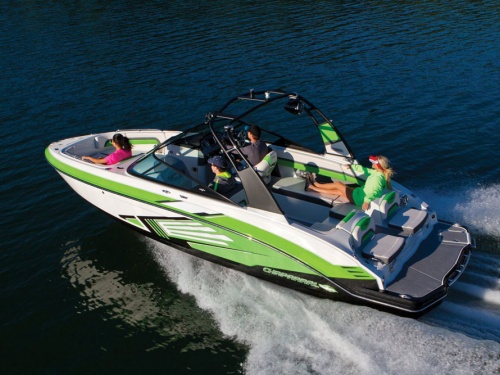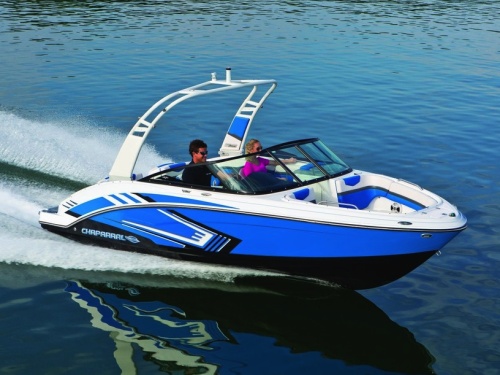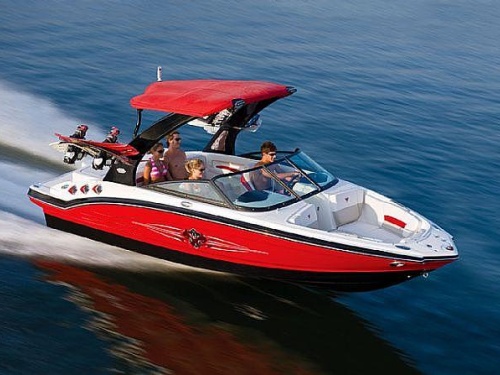Access More Boat Tests
Already have an account? Login
Chaparral 223 VRX (2015-)
2 x 205-hp Rotax 4-TEC 200 1.5L
Price
See the price by becoming
a BoatTEST member.
Members Must Log In
Brief Summary
The second of six jet boat launches, the 223 VRX is every bit the Chaparral we expected her to be. She seats 10 in comfort, and as a watersports platform she’s sure to thrill. Acceleration was brisk, but it was her handling that convinced us that she’s pure Chaparral. No chinewalk in turns, clean wake penetration, and a solid feel. Top speed during testing ...52.9 mph.
Key Features
- Sport arch with Bimini
- Lateral Thrust steering
- Vinyl dash with contrasting color stitching color-matched to hull scheme
- Twin Rotax 4-TEC engines
- combined anchor storage with bow reboarding ladder
- Side mount cockpit pedestal table
- Cockpit wraparound seating
- Wet Sounds speakers
- Glove box with stereo, MP3 input and storage
Test Results
| RPM | MPH | Knots | GPH | MPG | NMPG | STAT. MILE | NM | dBa |
|---|---|---|---|---|---|---|---|---|
| 1800 | 4.7 | 4 | 1.5 | 3.1 | 2.7 | 140 | 121.3 | 77 |
| 2000 | 5.2 | 4.5 | 1.7 | 3.2 | 2.7 | 142 | 123.3 | 80 |
| 2500 | 6.3 | 5.4 | 2.2 | 2.8 | 2.5 | 128 | 111.2 | 80 |
| 3000 | 6.8 | 5.9 | 3.1 | 2.2 | 1.9 | 100 | 87.2 | 85 |
| 3500 | 7.6 | 6.6 | 3.9 | 2 | 1.7 | 88 | 76.7 | 92 |
| 4000 | 8.7 | 7.5 | 5 | 1.7 | 1.5 | 79 | 68.4 | 91 |
| 4500 | 18.6 | 16.2 | 6.1 | 3 | 2.7 | 137 | 119.3 | 96 |
| 5000 | 25.9 | 22.5 | 8.1 | 3.2 | 2.8 | 144 | 125.1 | 96 |
| 5500 | 31.6 | 27.5 | 10.7 | 3 | 2.6 | 133 | 115.6 | 98 |
| 6000 | 35.4 | 30.8 | 13.1 | 2.7 | 2.3 | 122 | 105.7 | 95 |
| 6500 | 40.3 | 35 | 17.6 | 2.3 | 2 | 103 | 89.9 | 96 |
| 7000 | 44.7 | 38.9 | 21.8 | 2.1 | 1.8 | 92 | 80.2 | 100 |
| 7500 | 48.8 | 42.4 | 30.5 | 1.6 | 1.4 | 72 | 62.6 | 101 |
| 7580 | 50 | 43.5 | 31.3 | 1.6 | 1.4 | 72 | 62.5 | 100 |
| 7850 | 52.9 | 46 | 32.8 | 1.6 | 1.4 | 73 | 63.1 | 100 |
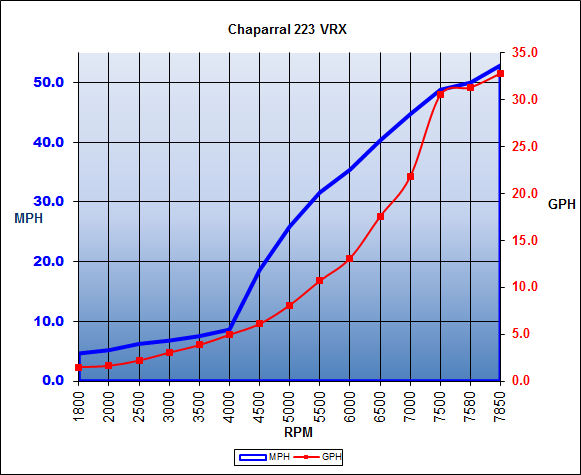
Specifications
| Length Overall | 22' 3'' / 6.78 m |
|---|---|
| Beam |
8' 6'' 2.59 m |
| Dry Weight |
3,100 lbs. 1,406 kg |
| Tested Weight |
3,745 lbs. 1,699 kg |
| Draft |
16'' 41 cm |
| Deadrise/Transom | 20-deg. |
| Max Headroom | open |
| Bridge Clearance |
7' 7'' 2.31 m |
| Fuel Capacity |
50 gal. 189 L |
| Water Capacity | N/A |
| Total Weight |
3,745 lbs. 1,699 kg |
Acceleration Times & Conditions
| Time to Plane | 2.1 sec. |
|---|---|
| 0 to 30 | 6.2 sec. |
| Ratio | N/A |
| Props | 159mm impellers |
| Load | 2 persons, 3/4 fuel, no water, 50 lbs. of gear |
| Climate | 85.6 deg., 76 humid.; wind: 0-0 mph; seas: flat |
Engine Options
| Tested Engine |
2 x 205-hp Rotax 4-TEC 200 1.5L |
|---|---|
| Std. Power |
Not Available |
| Opt. Power |
2 x 150-hp Rotax 4-TEC 150 ECT 2 x 200-hp Rotax 4-TEC 200 ECT 2 x 250-hp Rotax 4-TEC 250 ECT |
 Learn More
Learn More
Watch Our Video
Contents of Report
- Mission Statement
- Distinguishing Features
- Engines
- Performance
- Handling
- Docking
- Features Inspection
- Seating
- Pricing
- Observations
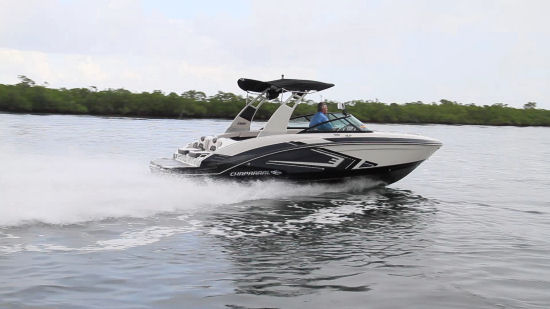
The Chaparral 223 VRX has a LOA of 22’3” (6.78 m), a beam of 8’6" (2.59 m) and a draft of 16'' (41 cm).
Mission Statement
The goal of the 223 VRX was to serve as a 22’ (6.70 m) twin engine, jet propelled boat with luxury appointments and Chaparral DNA. That seems like a big set of shoes to fill but Chaparral managed to pull it off and come away with a boat that is not only comfortable, but a heck of a lot of fun to drive.
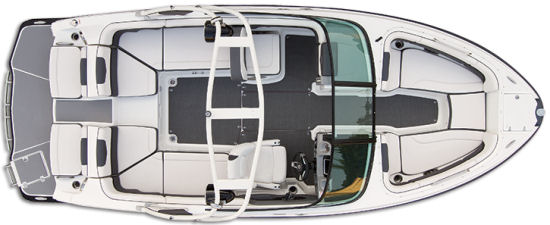 The cockpit sides are pushed right up against the hull sides creating a more roomy boat that can seat 10.
The cockpit sides are pushed right up against the hull sides creating a more roomy boat that can seat 10.
Distinguishing Features
Helm Layout
The helm is fabricated in gray tones that remove any concern for glare or adverse reflection in the windshield. A vinyl dash is stitched into place with contrast color stitching that is color-matched to the hull scheme.
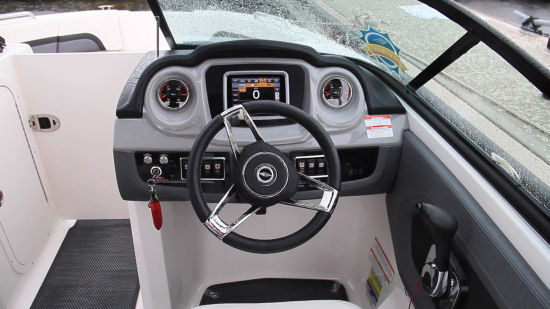 Chaparral always manages to keep its helms looking orderly, and the 6.5” (16.5 cm) touchscreen eliminates the need for gauges.
Chaparral always manages to keep its helms looking orderly, and the 6.5” (16.5 cm) touchscreen eliminates the need for gauges.
This is a twin-engine boat with dual starters just above the ignition key to the left of the helm. However, both engines are controlled from a single control at the helm. There’s no putting one engine forward and the other in reverse to pivot the boat, but as we’ll come to see in the handling section, it’s not needed.
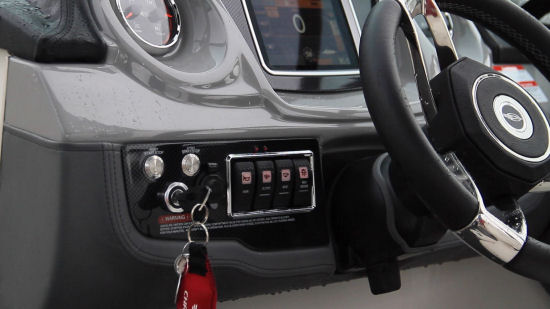 Twin engine start/stop buttons are just above the single ignition key.
Twin engine start/stop buttons are just above the single ignition key.
Two gauges are recessed into molded placements to either side of the Medallion touchscreen display. By adding this optional screen, Chaparral removed the need for additional gauges, thereby cleaning up the panel considerably.
The touchscreen with Rotax Speed-control functions display has a lot to offer.
Of course it also has the selection to display the engine gauges and even control the upgraded stereo.
The Rotax Difference
Chaparral went with Rotax 4-TEC engines and they have some distinct advantages. Most notably… lateral thrust control.
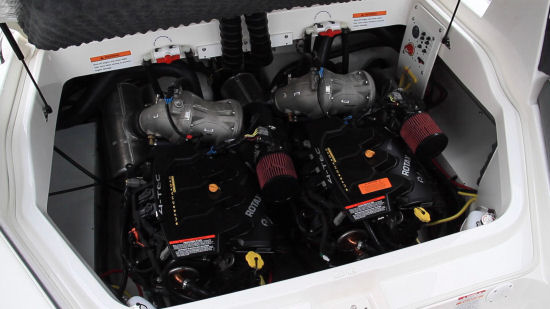 Twin Rotax engines provide the power for the 223 VRX and are available in three sizes. The silver components at the top are the catalytic converters. The battery switch is to the right, which is also accessed from the aft seat at the transom.
Twin Rotax engines provide the power for the 223 VRX and are available in three sizes. The silver components at the top are the catalytic converters. The battery switch is to the right, which is also accessed from the aft seat at the transom.
Lateral thrust control is accomplished by departing from the traditional method of attaching the thrust deflector bucket to the thrust nozzle. Instead, the bucket is attached aft of the steering nozzle, and it’s more elongated, with open ends allowing the thrust to come out the sides when in neutral or reverse.
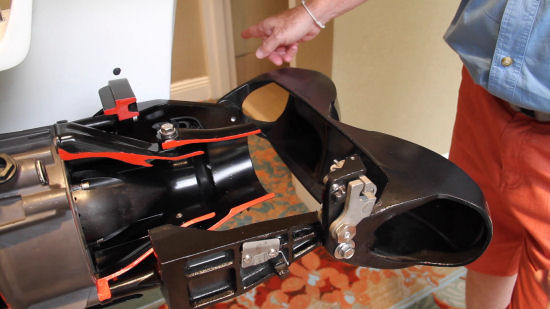 Here we can see the cutaway jet nozzle and the long bucket with the opening at the sides. This directs the thrust out the sides, more so when the nozzle is steered.
Here we can see the cutaway jet nozzle and the long bucket with the opening at the sides. This directs the thrust out the sides, more so when the nozzle is steered.
This provides for some amazing maneuverability at the dock. She’ll easily pivot in her own length, and with some deft touches that we discussed in the docking section, the 223 VRX can practically dock with the agility of a pod drive boat.
Closed cooling is a feature that will appeal particularly to salt-water boaters. The running pad is actually a heat exchanger. A hose runs to the thermostat and water pump cooling the engine with the cooling effects of having this pad underwater.
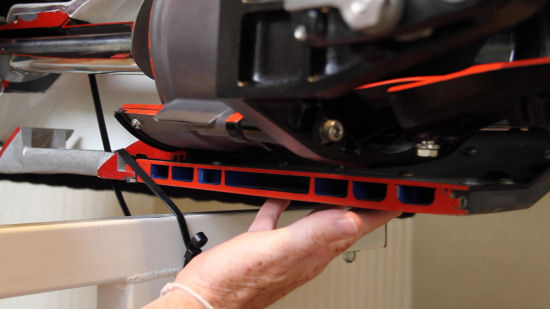 The ride plate will accommodate anti-freeze flowing through that will get cooled from the plate itself being underwater. Cooled anti-freeze then flows through the engine.
The ride plate will accommodate anti-freeze flowing through that will get cooled from the plate itself being underwater. Cooled anti-freeze then flows through the engine.
Shaft protection is achieved by enclosing the shaft in a stainless tube. Normally we have access ports allowing us to reach our hands down to the shaft to clear weeds. Here, the shaft is protected from ever getting fouled in the first place. Does the impeller get fouled? Sure, same as the competition, but no builder in its right mind allows access to the impeller. That gets cleared with a boost of power to send any weeds on their way. A grate over the intakes prevents larger objects from entering the flow that goes through the thrust ducts. If those get clogged, typically all it takes is shutting down and letting gravity do its thing.
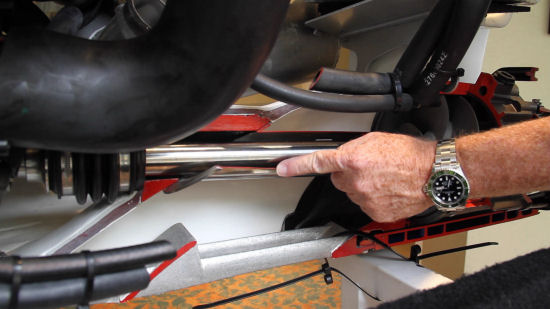 Here the shaft is protected by a stainless tube, seen here cut in half. Below is the cutaway of the grate keeping large objects out of the impeller.
Here the shaft is protected by a stainless tube, seen here cut in half. Below is the cutaway of the grate keeping large objects out of the impeller.
Power choices for the 223 VRX are either a pair of Rotax 4-TEC 150 ECT, Rotax 4-TEC 200 ECT or Rotax 4-TEC 250 ECT. We tested her with a pair of the midrange engines, the 200 ECT.
Performance
With the Rotax 4-TEC 200 engines powering our test boat, we reached a top speed of 52.9 mph at 7850 rpm. At that speed we were burning 31.3 gph giving us a range of 72 miles. That may seem like a high fuel burn but the simple fact is that these engines work hard at full settings. Even an increase in rpm from 7000 to 7500 will increase the fuel burn by nearly 10 gph. But keep things more sedate and the fuel burn is much more reasonable.
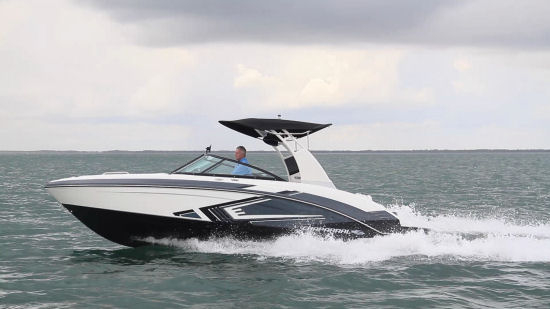 Our best cruise was found to be at 5000 rpm and 25.9 mph.
Our best cruise was found to be at 5000 rpm and 25.9 mph.
Best cruise setting was found to be at 5000 rpm and 25.9 mph. That speed produced a fuel burn of 8.1 gph, much more typical of what we normally see from a boat this size. Use the Medallion touchscreen’s cruise mode to set a maximum speed of 7000 rpm and 44.7 mph and max the fuel burn at 21.8 gph. Above that, it gets pricey.
But the real treat of her performance comes from her acceleration. Slam the throttle forward and hang on as she hits planing speed in 2.1 seconds, accelerates to 20 mph in 4 seconds and continues on through 30 mph in 6.2 seconds.
Handling
Her handling is a mix of classic Chaparral and jet boat. The Chaparral handling that she exhibits has to do with subtle wave penetration that keeps spray low and wide for a dry ride. In turns she carves well as she comes around without any tendency to fall off the turn with no hint of chine walk.
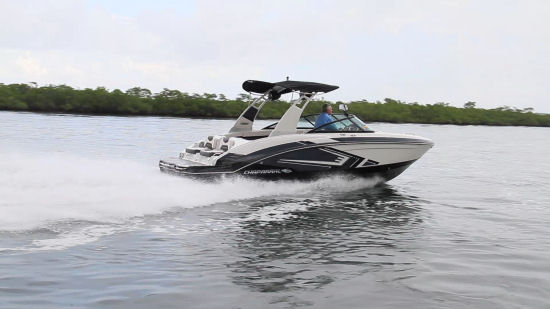 The 223 VRX has a hull that’s all Chaparral. She keeps spray down low for a dry ride.
The 223 VRX has a hull that’s all Chaparral. She keeps spray down low for a dry ride.
The “jet boat” handling comes into play when the “drive it like you stole it” mentality comes to play. In hard over aggressive turns she’ll spin out just like any other jet. Then she’ll launch off into the other direction with her brisk acceleration. It’s fun to drive this way but it’s hard on the passengers, so choose accordingly.
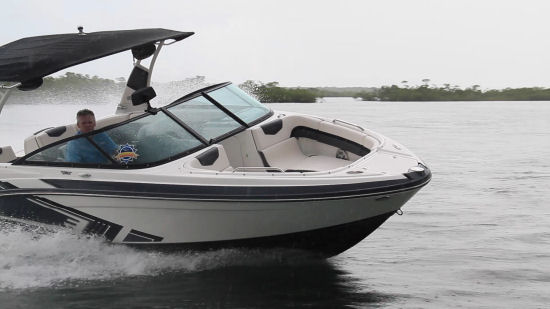 In normal turns the 223 VRX leans just 10-degrees into the turn, remaining comfortable throughout.
In normal turns the 223 VRX leans just 10-degrees into the turn, remaining comfortable throughout.
Docking
For side-to docking, approach the dock straight on. Of course before hitting the dock, turn the wheel hard over, say to the left in this case. Now leave it there and shift into neutral. Rotax's lateral steering will allow the thrust to continue to steer her. Keep the thumb pressed on the shifter and now ease her gently from forward to reverse and she’ll not only come around, she’ll start to slide sideways to the dock. It may be necessary to take a little turn off the wheel but this back and forth, in and out of forward and reverse, will serve the job well and it quickly becomes easy to control. When close enough, shut the engines off with the key and she’ll stop in position.
That last part is important… shutting off the engines. With the engines running there’s always thrust so it will only end up pushing the boat out of position. Shut her down and she’ll sit (all things being equal, like wind and current).
For backing into a slip, use the same technique of shifting in and out of gear with the thumb held onto the shift release. But now, do not steer the stern. Because things are opposite it will mess with the approach. Instead, steer the bow. Want the stern to come left, steer the bow right and over she’ll come. It actually is quick to get the hang of and takes longer to write about than to learn it.
But the simple fact is, this is a boat that will rarely see a dock. She’s a trailer boat through and through so really… don’t sweat the docking thing.
Features Inspection
Amenities
Anchor/Ladder
One of our favorite aspects of the amenities list is that Chaparral seemed to figure out how to do something that few other builders seem to be able to… combine the anchor storage with a bow reboarding ladder. In nearly all cases this is an “either/or” proposition. Not so here.
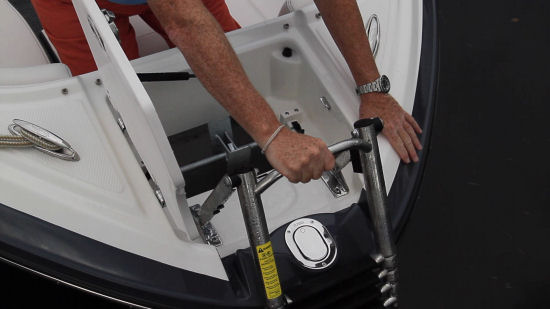 Chaparral managed to fit both a reboarding ladder and an anchor in the forward compartment. The navigation light flips for use and the 5” (12.7 cm) cleats are a full 1” (2.5 cm) larger than the competition.
Chaparral managed to fit both a reboarding ladder and an anchor in the forward compartment. The navigation light flips for use and the 5” (12.7 cm) cleats are a full 1” (2.5 cm) larger than the competition.
Under the hatch, with a lift-and-lock latch, is a four-step reboarding ladder with the anchor and keeper just underneath. Sure it’s required that the ladder be deployed to use the anchor but so what? Fair tradeoff to using both. The navigation light at the bow is flush mounted and simply gets flipped up for use.
Walkthrough
The walkthrough to the bow has the usual opening windshield. This one is held in the open position with a strap-and-snap. The space below can be closed off by an air dam, which lays flush against the helm console when not in use. When in the open position, where we typically see an open space to the helm storage, here we see another hatch keeping the storage secure/dry.
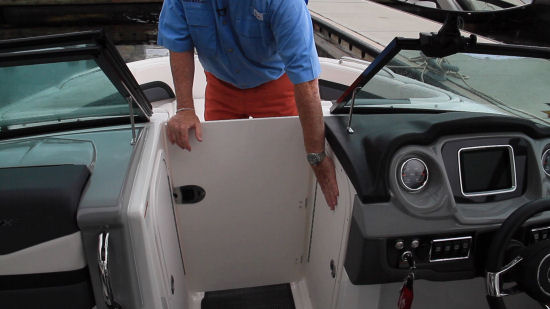 The air dam lies flush to the helm console and another hatch keeps the storage secure when the dam is in use.
The air dam lies flush to the helm console and another hatch keeps the storage secure when the dam is in use.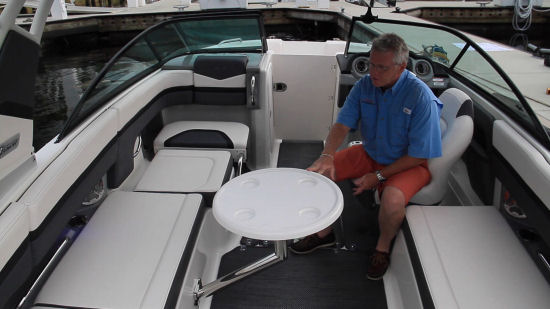 A side mount pedestal table turns the cockpit, with its wraparound seating, into an entertainment area.
A side mount pedestal table turns the cockpit, with its wraparound seating, into an entertainment area.
Arch
The VRX package includes a sport arch with a Bimini. Its powder coated with a raised texture that adds to the rail’s ability to maintain a firm grip with the hand. There’s padding to the lower sides and the entire arch is collapsible for easy storage in the garage.
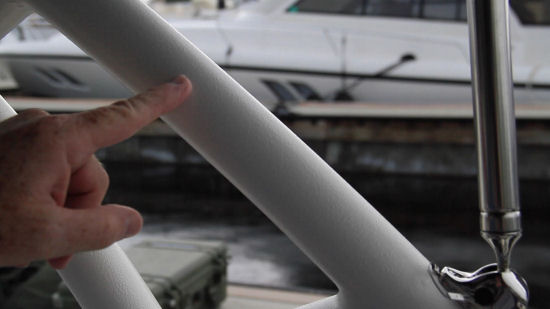 The texture of the arch pipes promotes being able to keep a good grip.
The texture of the arch pipes promotes being able to keep a good grip.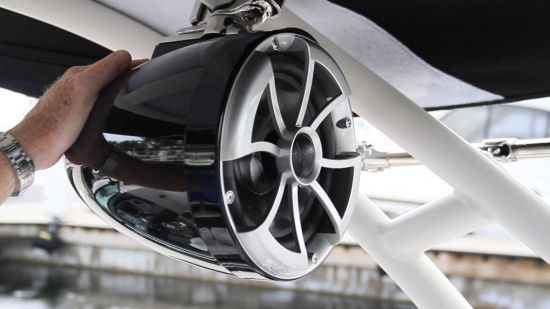 Wet Sounds speakers project the sound behind the boat, right into the ears of the wakeboarder.
Wet Sounds speakers project the sound behind the boat, right into the ears of the wakeboarder.
The Bimini top is supported with hardware through the perimeter. Where we typically see the tensioners residing right over the heads of the operator and observer, here it’s in the center, out of the way. Further, this top has a padded center that eliminates flapping as well as reducing chafe against the tower pipes. It’s also got a pair of aft-facing Wet Sounds speakers, part of the upgraded stereo system that includes six 6" (15.2 cm) speakers and a subwoofer.
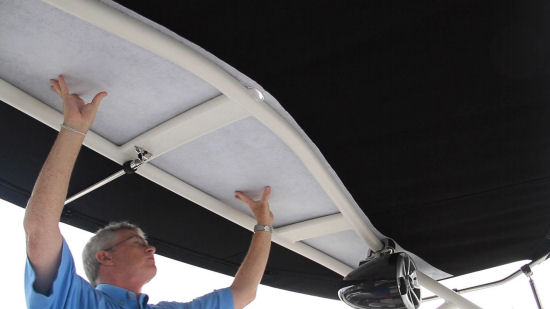 The Bimini top includes padding to stop the flapping in the breeze and also eliminate chafe.
The Bimini top includes padding to stop the flapping in the breeze and also eliminate chafe.
Now here’s where it gets cool…. the towpoint at the top of the tower includes a Go-Pro mount and there’s Bluetooth connectivity to the video screen at the helm.
Seating
Bow
Bow seating consists of the usual layout of two bench seats to either side with a cushioned seat separating them at the forward end. Storage is underneath the side seats and the cushions are hinged from the rear. Forward, the cushion lifts to reveal a non-skid step to the bow with a built-in insulated, self-draining cooler below. This space also has a flip-out stainless “tongue” to rest the bow filler cushion on to create the usual sun pad.
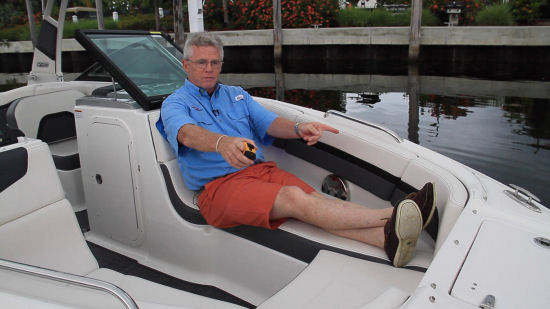 The bow seats are 13” (33 cm) off the deck and are separated by 24” (61 cm), allowing two people to face each other without banging knees. Bolsters are separated from 5’9” (1.8 m) at the rear and 3’3” (1 m) at the bow.
The bow seats are 13” (33 cm) off the deck and are separated by 24” (61 cm), allowing two people to face each other without banging knees. Bolsters are separated from 5’9” (1.8 m) at the rear and 3’3” (1 m) at the bow.
At the caprails are stainless grabrails, and while this may be nothing new, Chaparral has an interesting take on them. These have an elliptical cross section, which makes them easier for small hands to wrap around. Much safer for when kids are riding in the bow, as they always want to do.
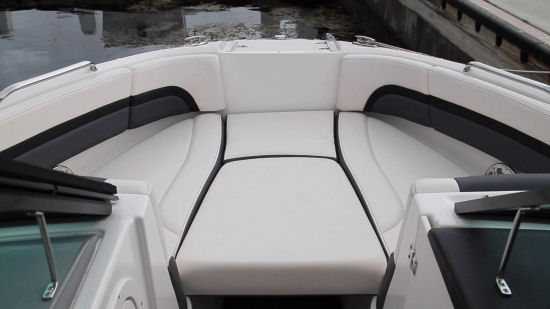 The bow accepts a filler cushion to create a forward sun pad.
The bow accepts a filler cushion to create a forward sun pad.
The marine-grade vinyl is 38-millimeters thick and there’s a 10-millimeter topcoat for protection. The stitching is all a contrasting color to the vinyl, but color-matched to the hull scheme… all done in-house. The foam cushioning…multi-density to add more support where needed.
Companion Seat
To the port side of the helm is a convertible companion seat. In the normal, forward-facing, position there’s a padded armrest to the port bulkhead. Forward is a padded hatch to the “glovebox” that houses the stereo, MP3 input and small storage accommodations.
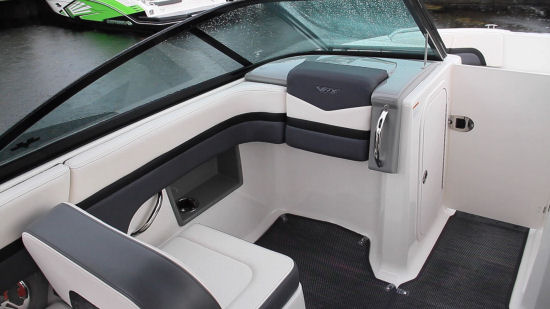 The portside seat offers plenty of legroom and a place to put the drink. Storage and the stereo are ahead under the padded hatch.
The portside seat offers plenty of legroom and a place to put the drink. Storage and the stereo are ahead under the padded hatch.
With the seatback flipped ahead, the seating lies flush to serve for sunning, or the padded glovebox becomes the “aft facing” seatback. In this manner the seat serves well as an observer’s seat for watching the action at the end of the towline.
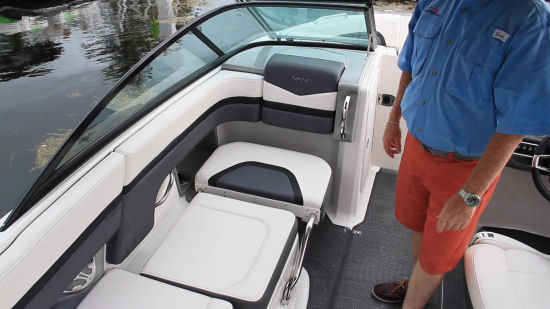 With the seatback laying forward the seat can be used for lying down or sitting aft facing with the padded glove box lid forming the new seatback.
With the seatback laying forward the seat can be used for lying down or sitting aft facing with the padded glove box lid forming the new seatback.
Stern
The most attractive seating is at the stern where Chaparral included dual aft facing seats that are well suited for whenever the 223 is at rest. Some may find this convenient for use as a staging area for putting boards on, other may see it as an ideal place for watching the kids swim off the stern. The choices are endless.
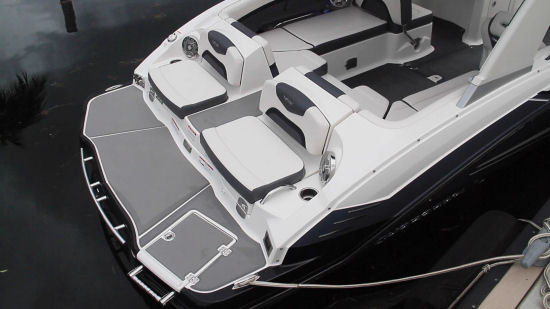 The aft seats are a great place to relax anytime when the 223 is at rest.
The aft seats are a great place to relax anytime when the 223 is at rest.
Both seats are separated by the walkthrough to the cockpit. The seat cushions lift but this area leads deep into the battery compartment to one side and the bilge to the other.
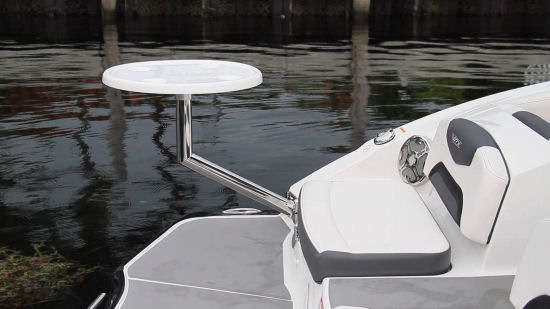 Adding a pedestal table to the stern makes the area even more enjoyable.
Adding a pedestal table to the stern makes the area even more enjoyable.
Pricing
The Chaparral 223 VRX we tested had a base price, with the twin 200 engines, of $53,445. It included several options to the package including an upgraded aluminum trailer with galvanized wheels ($1,190), a spare tire kit for the trailer ($245), the upgraded sound system ($1,995), a leather steering wheel upgrade ($399), a water toy inflator ($100), a cockpit and bow cover ($806), the galvanized anchor ($80) and the snap-in carpet ($450), bringing her loaded “as tested” price to $58,960.
Observations
Jet boats aren’t without their quirks but neither is any boat. Take it from people who drive hundreds of different boats every year. This one has a learning curve that can’t be denied, but we spent all of five minutes “getting the hang” of her at the dock, and in that short time were able to maneuver her flawlessly. It’s not hard and shouldn’t allow the advantages of not having a spinning propeller under the boat to be underscored.
Above all, she’s a Chaparral, and that name will make this a much sought after brand in its own right. Chaparral’s insistence on keeping that DNA seems to have paid off and the combination is pretty enjoyable.


